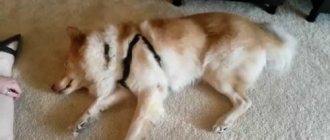Syncope or fainting is a specific reaction of the body to a violation of cerebral circulation. Fainting is characterized by temporary loss of consciousness and spontaneous recovery.
Syncope does not refer to diseases, but to symptoms of serious disorders in the body. In advanced cases, fainting in a dog can be fatal.
Even a single loss of consciousness in a dog is a reason to immediately seek help from a veterinary clinic. There are a huge number of causes of fainting.
Possible causes of fainting in dogs
There may be several reasons why a dog faints. This happens even from an excess of emotions, severe fear or excessive happiness. Rarely, dogs lose consciousness when meeting their owner, from whom they suffered from a long separation and missed her greatly.
Fainting dog
For your information! A loud bang or explosion can frighten and deafen your pet, resulting in loss of consciousness. Small dogs, for example, should not be taken to noisy celebrations accompanied by fireworks and fireworks. For them, a large crowd of people is already a huge stress.
The animal may faint from overheating or hypothermia. You should always monitor weather conditions and make sure your pet is comfortable. A dog can pass out from the heat, whether it's a puppy or an old dog. The scorching sun is dangerous for all animals, especially furry ones and pets with black fur. Therefore, in the summer, many people prefer to cut their pets' hair, even if this makes them lose their attractiveness. Frostbite usually starts from the extremities; it is the paws that freeze first. No less dangerous is the sudden movement of a pet from the cold to a hot and stuffy room. Changes in temperature can negatively affect its condition.
The following can also cause a dog to faint:
- lack of nutrients, systematic malnutrition;
- poisoning;
- wound or other serious injury accompanied by large loss of blood;
- prolonged stay in moving vehicles, especially without access to fresh air.
Note! There was a recorded case where a dog pretended to faint. She tried to avoid having her nails trimmed, and as soon as her owner approached her with a tool, she fell on her side.
The most dangerous reason for a dog to faint is problems with the heart or blood vessels. After such an incident, the dog should be shown to a doctor in any case, even if there is confidence that this happened due to the heat and the animal felt better. Only a specialist can assess the dog’s condition and determine the true cause of the illness.
Visit to the veterinarian
The effect of negative environmental factors
Dogs are not living automata, nor biorobots. As is the case with people, they can be adversely affected by negative environmental factors:
- Intense heat and stuffiness in the room. Bulldogs, pugs, boxers, and other dogs with a brachycephalic skull structure are especially intolerant of elevated temperatures. You should not go for a walk with such pets in hot and stuffy weather. In addition, it doesn’t hurt to install a fan or air conditioner.
- The action of strong stress factors. If a house where a dog has lived calmly and freely for several years suddenly starts renovations with the demolition of half the walls, then all these measures will not have the best effect on the pet’s health.
- Doggies of “pocket” formats very often have an incredibly hot-tempered and excitable disposition, which is why fainting is an almost habitual condition for them. When keeping such animals, they should be protected as much as possible from the influence of stress factors, otherwise “harmless” moments of loss of consciousness can develop into epilepsy.
Symptoms and identification of causes
Why does a dog howl at night in the yard: reasons
Immediately before fainting, the dog's behavior changes. Usually she becomes lethargic and looks for a secluded place. Coordination of movements is often disturbed, the animal barks for no reason, and its voice is not always immediately recognizable. The dog feels sick and often starts vomiting.
For your information! A dog may have a bowel movement; this is a spontaneous action that the animal cannot control or stop.
If you carefully examine the animal, you will notice:
- slow pulse;
- decreased body temperature;
- pallor of eyelids and lips;
- The dog's paw pads are cold.
Treatment of the disease
Before a diagnosis is made, treatment of seizures in dogs can only be symptomatic, that is, it relieves the main symptoms and improves the general condition of the animal. Anticonvulsant therapy begins with intramuscular injections of magnesium sulfate (magnesium). Based on the diagnostic results, the doctor determines the main cause of seizures and prescribes specific treatment to the patient. It may happen that the animal may need medications to relieve neurological symptoms for the rest of its life.
The owner is required to strictly follow all the doctor’s recommendations. You cannot stop prescribed therapy without permission to avoid recurrence of attacks.
Types of seizures
Why does your Yorkie tremble at home and stick out its tongue: reasons
It happens that a dog's fainting is accompanied by convulsions or they precede loss of consciousness. Some of them are not dangerous, others require immediate attention to a veterinarian.
The following types of seizures are distinguished:
- convulsions. It is not always easy to notice them; the dog’s paws twitch slightly. In this case, the animal is usually conscious and responds to the owner’s voice;
- tonic convulsions. Muscles contract after a certain period of time. The dog feels discomfort and even pain, so it may whine;
- clonic convulsions. The muscles tense and then relax. The time interval between convulsions can vary: from 30 seconds. up to a couple of minutes. The dog has difficulty controlling its body at the moment of muscle tension and may fall on its side;
- epileptic seizures. The pet's condition resembles a seizure. He cannot move, he is constantly tense. His body relaxes for only a few seconds, and then the muscles spasm again. He is unconscious, his eyes are rolling back. However, they are not necessarily closed. This condition is dangerous for the dog and requires medical attention.
Prevention measures
There is no special system for preventing these conditions. The main means of prevention are, first of all, a healthy lifestyle - good nutrition, walks with the dog in the fresh air, active games. Regular preventive examinations are important to ensure that the onset of the disease is not missed. Seizures in dogs of most small breeds can begin after suffering stress, because they are very timid. We must ensure that such situations are created for them as little as possible.
Pedigree dogs are most predisposed to this disease. Why this is so is still unknown. Dogs of the poodle, husky, and dachshund breeds are often diagnosed with epilepsy, and Yorkshire terriers, Chihuahuas, and Spitz dogs are susceptible to hypoglycemia.
What happens when you faint
The dog does not drink water but eats: reasons for how to get a puppy to drink
At the moment of fainting, the animal's brain receives little oxygen. It is not enough for full functioning. Blood circulation and supply of nutrients are disrupted, muscles lose tone, resulting in loss of consciousness. In some cases it may persist. But usually the pet does not react to the owner and does not feel touch.
Note! If the problem is neurological, then it is the brain or spinal cord that is involved. When an animal has cardiac problems, you can notice, for example, an arrhythmia, in which the rhythm of the heart is disturbed.
Diagnostics
In order to prevent the serious consequences of this disease, it is necessary to seek advice from a veterinarian as soon as possible, who will identify the cause of the disease and draw up a treatment regimen.
First of all, when diagnosing epilepsy, it is necessary to understand whether the disease is congenital or appears due to the influence of acquired factors.
To make an accurate diagnosis, specialists collect a detailed history and prescribe clinical studies. A video recording of the attack made by the owner can also help in making a diagnosis.
As a rule, to detect epilepsy, veterinarians conduct a complete neurological examination of the dog, and also prescribe x-rays, laboratory blood and urine tests, reflexology examination, MRI of the brain, and ultrasound diagnostics.
What should the owner do?
If a dog faints, the owner should not panic. You need to provide first aid:
- Remove all pressure objects and clothing. Harnesses, leashes, and muzzles can worsen the condition.
- It is advisable to place the animal on its side, especially if it has been vomiting. In this case, it is necessary to clear the animal’s mouth of food debris and wipe its face. While the dog is unconscious, there is no need to give him water. As soon as he comes to his senses and can lap, give cool water.
- The head should be lower than the body, which will ensure blood flow to it.
- If your pet becomes ill in the heat, use a damp bandage. A cold compress can be placed under the head. If the dog is cold, warm it up, first of all with its paws. If you don't have a heating pad on hand, you can use a bottle filled with warm water.
- Make sure that the tongue does not fall inside. If possible, it's better to pull it out.
Coordinated actions are required from the owner
Note! After the dog has regained consciousness, you need to go to the veterinarian to rule out the presence of dangerous diseases. If possible, call a doctor home so as not to disturb the animal again.
First aid
Sudden convulsions in a beloved dog should not lead the owner into confusion. This symptom is not so scary. Much more serious consequences can arise from injuries that the dog can inflict on itself during an attack. Therefore, the owner’s main task is to reduce this risk to a minimum. The most correct actions would be:
- make sure that the animal cannot get hurt; for this purpose, make sure that there are no piercing or cutting objects nearby;
- put the dog not on the bed, but on a soft bedding placed on the floor;
- hold the animal’s paws and head;
- put it on its side to prevent choking, make sure that foam and saliva flow freely from the mouth;
- to avoid damage to the dog’s teeth, try to insert an object (a spoon) between the jaws;
- carefully drop a few drops of a sedative (Corvalol or Valocordin) onto the tongue, this will help the attack end sooner;
- observe the dog’s behavior in order to later correctly describe its condition to the veterinarian;
- Call a veterinary service at home as soon as possible or, after waiting for the attack to end, bring the dog to a veterinary clinic.
It happens that the convulsions are quite prolonged; only an experienced veterinarian knows what to do in this case. Attempts to treat an animal with home methods can only worsen the situation.
Calling a veterinarian to your home
Many clinics provide doctor-call services at home. If the animal is weakened and moving is a big stress for him, then it is better to take advantage of this opportunity.
Private veterinarians acting independently also work this way. It is advisable to contact them only by recommendation, so as not to run into incompetent specialists. If you have time, it is better to read reviews about organizations. Some of them may not be genuine, especially neutral comments without details or specifics.
Important! If a clinic has a lot of reviews describing its specialists without names and without revealing the problems that they solved, you should doubt the reliability.
On the websites of some clinics there are online consultants who will answer your questions and tell you whether you need to transport your dog or whether it is better to wait for the doctor at home.
Experienced doctors arrive with all the necessary instruments, the sterility of which cannot be doubted. It would be good if they had the opportunity to do an ultrasound at home and take a cardiogram.
After fainting, the dog immediately feels better
The cost of services depends on the list of procedures performed and the qualifications of doctors. So, when calling a specialist or a doctor with a Ph.D. title, you will have to pay more than for a standard examination.
Possible consequences
Dog fainting should not be ignored. With the help of a doctor, you need to determine the cause in order to prevent the pet’s health problems from worsening. If you do not find out what causes loss of consciousness, then such cases may become more frequent. Your pet may be developing heart problems that can be prevented at an early stage. This will prolong the dog's life, and it will be happy for many years.
Note! In any case, when the animal is unconscious, oxygen does not reach its brain: for a puppy this can affect its development, but for an adult pet it can end extremely sadly.
A dog's health depends on careful care
Pet owners need to carefully monitor their health. After all, the quality and duration of their life depends on this. It is imperative to find out why the dog loses consciousness, especially if this happens more than once. You cannot self-medicate, trusting to chance. Only a veterinarian can find the factor that provoked fainting and help avoid this in the future.
General information
The term “fainting” refers to a short period of unconsciousness caused by insufficient oxygen supply to the brain. It lasts, it can be from a few seconds to a couple of minutes. What are the causes of fainting in dogs?
Most fainting occurs due to hypoxia , often this happens with low blood pressure. This phenomenon is not a disease, but often indicates the presence of some kind of pathology. So, if your dog constantly switches off for no apparent reason, this may indicate the presence of a tumor in his brain.
Blood pressure indicators depend on the condition of the heart and vascular bed. Accordingly, diseases of the heart or blood vessels (cardiovascular system) are the most common causes of fainting. There are often cases when a dog “departs” due to problems with the conductive structures of the heart (blockade of the bundles). Some structural heart disease (cardiomyopathy) or pericardial disease that interferes with the normal process of heart contraction may also be to blame.
Please note! Fainting of cardiac etiology is extremely dangerous, as it can lead to severe morphofunctional disorders of the brain (they last a long time).
Like people, some dogs are characterized by increased nervous excitability, and fainting in their case may be due to “physiological” reasons. So, some dogs faint from joy . Of course, such cases are rare, but they should not be completely ruled out.
Other causes that can lead to fainting in dogs include: severe respiratory disease (even a severe cough may be to blame in some cases), metabolic diseases, endocrine gland disorders, vegetative-vascular dystonia, anemia (this is a very common predisposing factor) and some medications. The less the dog faints, the less dangerous it is for the animal’s body.











